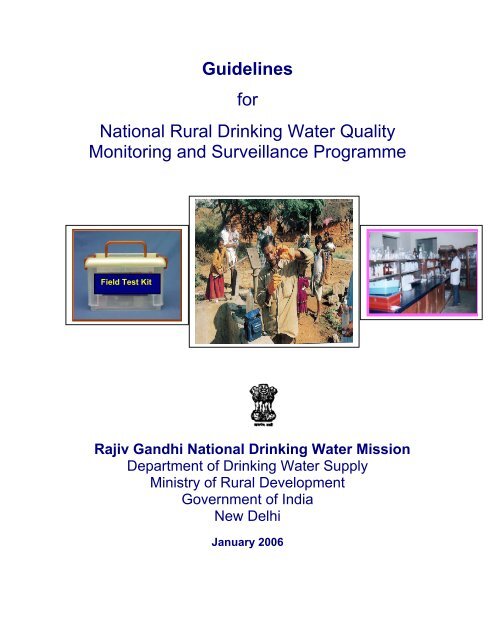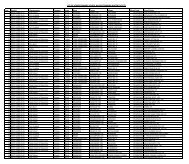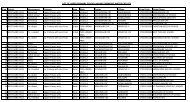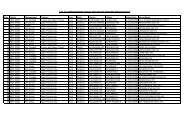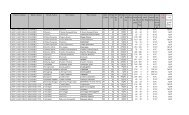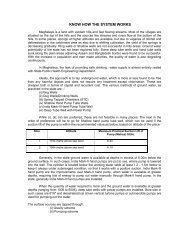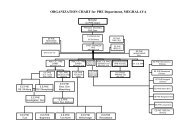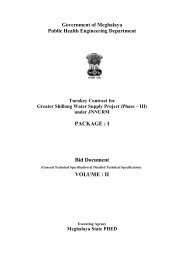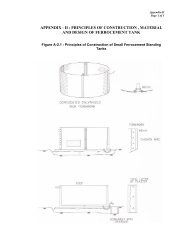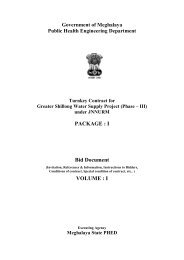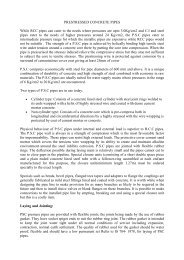Guidelines for National Rural Drinking Water Quality Monitoring and ...
Guidelines for National Rural Drinking Water Quality Monitoring and ...
Guidelines for National Rural Drinking Water Quality Monitoring and ...
You also want an ePaper? Increase the reach of your titles
YUMPU automatically turns print PDFs into web optimized ePapers that Google loves.
<strong>Guidelines</strong><br />
<strong>for</strong><br />
<strong>National</strong> <strong>Rural</strong> <strong>Drinking</strong> <strong>Water</strong> <strong>Quality</strong><br />
<strong>Monitoring</strong> <strong>and</strong> Surveillance Programme<br />
Field Test Kit<br />
Rajiv G<strong>and</strong>hi <strong>National</strong> <strong>Drinking</strong> <strong>Water</strong> Mission<br />
Department of <strong>Drinking</strong> <strong>Water</strong> Supply<br />
Ministry of <strong>Rural</strong> Development<br />
Government of India<br />
New Delhi<br />
January 2006
Contents<br />
Item<br />
No.<br />
Particulars Page Number<br />
1.0 Background 1<br />
2.0 Objectives 2<br />
3.0 Strategy 2<br />
4.0 Funding 3<br />
5.0 Illustrative list of activities under IEC<br />
<strong>and</strong> HRD<br />
4<br />
6.0 Cost Norms 5<br />
7.0 Community contribution 6<br />
8.0 <strong>Monitoring</strong> of the Programme 7<br />
9.0 Reports 7<br />
10.0 Annual Audit 7<br />
Suggested Media & Communication<br />
Strategy<br />
Annex-1
ABBREVIATIONS USED IN THE GUIDELINES<br />
WHO World Health Organization<br />
UNICEF United Nations Children’s Education Fund<br />
NRI <strong>National</strong> Referral Institute<br />
NICD <strong>National</strong> Institute of Communicable Diseases<br />
SRI State Referral Institute<br />
NRDWQM&SP <strong>National</strong> <strong>Rural</strong> <strong>Drinking</strong> <strong>Water</strong> <strong>Quality</strong> <strong>Monitoring</strong> &<br />
Surveillance Programme<br />
O&M Operation & Maintenance<br />
DDWS Department of <strong>Drinking</strong> <strong>Water</strong> Supply<br />
SHG Self Help Group<br />
NGO Non-Governmental Organization<br />
IEC In<strong>for</strong>mation, Education & Communication<br />
HRD Human Resource Development<br />
CCDU Communication & Capacity Development Unit<br />
SWSM State <strong>Water</strong> & Sanitation Mission<br />
DWSM District water & Sanitation Mission<br />
PHED Public Health Engineering Department<br />
VWSC Village <strong>Water</strong> & Sanitation Committee<br />
GP Gram Panchayat<br />
ARWSP Accelerated <strong>Rural</strong> <strong>Water</strong> Supply Programme<br />
PRI Panchayati Raj Institution<br />
TA/DA Traveling Allowance/Daily Allowance<br />
FTK Field Testing Kit<br />
ASHA Accredited Social Health Activist<br />
UT Union Territory<br />
MIS Management In<strong>for</strong>mation System
GUIDELINES FOR THE NATIONAL RURAL DRINKING WATER QUALITY<br />
MONITORING AND SURVEILLANCE PROGRAMME (NRDWQM&SP)<br />
1.0 BACKGROUND<br />
The <strong>National</strong> Workshop held on 7-9, August 1997 on ‘<strong>Water</strong> <strong>Quality</strong><br />
<strong>Monitoring</strong> <strong>and</strong> Surveillance’, jointly organized by Ministry of <strong>Rural</strong><br />
Development <strong>and</strong> Ministry of Health with support from WHO <strong>and</strong> UNICEF,<br />
had recommended institutionalization of drinking water quality monitoring<br />
<strong>and</strong> surveillance systems in the country. As drinking water quality<br />
monitoring, <strong>and</strong> quality surveillance are two distinct but closely related<br />
activities, requiring drinking water quality monitoring by suppliers of the<br />
drinking water <strong>and</strong> surveillance by the Health authorities, the workshop<br />
had also recommended close collaboration between drinking water supply<br />
agencies <strong>and</strong> Health authorities all over the country. The enormous task of<br />
drinking water quality monitoring <strong>and</strong> surveillance in rural areas requires<br />
160 lakh samples to be tested annually with a norm of one sample per 200<br />
population.<br />
In order to institutionalize <strong>Water</strong> <strong>Quality</strong> <strong>Monitoring</strong> <strong>and</strong><br />
Surveillance systems four pilot projects were implemented in Nellore<br />
(Andhra Pradesh), Sehore (Madhya Pradesh), Allahabad (Uttar Pradesh)<br />
<strong>and</strong> Kangra (Himachal Pradesh) based on Catchment Area Approach.<br />
After analyzing the findings of these pilot projects, it has been decided to<br />
scale up the programme all over the country. Accordingly, an<br />
Implementation Manual on <strong>National</strong> <strong>Rural</strong> <strong>Drinking</strong> <strong>Water</strong> <strong>Quality</strong><br />
<strong>Monitoring</strong> <strong>and</strong> Surveillance Programme was got prepared through All<br />
India Institute of Hygiene <strong>and</strong> Public Health, which was circulated to all<br />
State Governments in January 2004.<br />
For implementation of the programme, operational aspects<br />
mentioned in the Implementation Manual on <strong>National</strong> <strong>Rural</strong> <strong>Water</strong> <strong>Quality</strong><br />
<strong>Monitoring</strong> <strong>and</strong> Surveillance Programme like drinking water quality<br />
st<strong>and</strong>ards, epidemiological <strong>and</strong> health aspects of water quality, sampling<br />
procedures, specifications <strong>for</strong> laboratory space, equipment, chemicals <strong>and</strong><br />
glassware’s <strong>for</strong> district water quality testing laboratories, role <strong>and</strong><br />
responsibilities of SRIs, NRI, etc. will be followed. Since the cost norms<br />
suggested in the Manual are outdated, <strong>and</strong> in some cases not specified, it<br />
is felt necessary to update the same on realistic basis <strong>and</strong> share with the<br />
States through these <strong>Guidelines</strong>. There<strong>for</strong>e, <strong>for</strong> cost norms, these<br />
<strong>Guidelines</strong> should be referred to <strong>for</strong> implementation of NRDWQM&SP.<br />
As the infrastructure available in the country <strong>for</strong> monitoring the<br />
quality of drinking water supply is inadequate it was decided to adopt a<br />
community based approach, involving the available sub-district level<br />
1
infrastructure <strong>for</strong> drinking water quality, testing e.g. educational, technical<br />
<strong>and</strong> private sector institutions.<br />
2.0 OBJECTIVES<br />
o <strong>Monitoring</strong> <strong>and</strong> surveillance of all drinking water sources in the<br />
country by the community.<br />
o Decentralization of water quality monitoring <strong>and</strong> surveillance of all<br />
rural drinking water sources in the country.<br />
o Institutionalization of community participation <strong>and</strong> involvement of<br />
PRIs <strong>for</strong> water quality monitoring <strong>and</strong> surveillance<br />
o Generation of awareness among the rural masses about the water<br />
quality issues <strong>and</strong> the problems related to water borne diseases.<br />
o Building capacity of Panchayats to own the field test kit <strong>and</strong> take up<br />
full O&M responsibility <strong>for</strong> water quality monitoring of all drinking<br />
water sources in their respective PRI area.<br />
3.0 STRATEGY<br />
At the <strong>National</strong> level:<br />
o The Department of <strong>Drinking</strong> <strong>Water</strong> Supply (DDWS) to monitor the<br />
entire programme.<br />
o <strong>National</strong> <strong>Drinking</strong> <strong>Water</strong> <strong>Quality</strong> Coordination Council to advise<br />
DDWS <strong>for</strong> planning <strong>and</strong> supervising the implementation of drinking<br />
water quality monitoring <strong>and</strong> surveillance in the States<br />
o Establishing a well structured in<strong>for</strong>mation flow between<br />
Government, Technical Institutes, District Laboratories <strong>and</strong> grassroot<br />
functionaries.<br />
o Identification of <strong>National</strong> Referral Institute (NRI)<br />
o Training to State level functionaries.<br />
At the State level:<br />
o Identification of State level Referral Institute<br />
o Taking up State <strong>and</strong> Region specific IEC activities involving PRIs,<br />
Co- operatives, Women Groups, SHGs, NGOs by CCDU/SWSM<br />
o HRD- Training to be imparted to district, block <strong>and</strong> GP level<br />
functionaries.<br />
o Testing of atleast 10 % of the samples tested which include<br />
positively tested samples by the district water quality testing<br />
laboratories apart from routine cross-verification by the State<br />
laboratory. The State level Laboratories would also be involved in<br />
testing concentrations of rare elements <strong>and</strong> extend all necessary<br />
2
help in providing water quality testing reports to the State<br />
Governments during the periods of natural calamity <strong>and</strong> disasters.<br />
o The district laboratories / PHED are expected to test at least 30 %<br />
of the water samples tested by GPs <strong>and</strong> compulsorily where<br />
possibility of contamination is reported by the community<br />
(VWSC/GPs).<br />
o The district <strong>and</strong> State laboratories shall compare the concentration<br />
of contaminants with respect to limits prescribed by Bureau of<br />
Indian St<strong>and</strong>ards in IS-10500.<br />
o Identification / Registration of safe drinking water sources in all rural<br />
habitations (Gram Panchayat wise)<br />
o Sanitary inspections of drinking water sources should be done<br />
atleast once in a year initially, there after as situation dem<strong>and</strong>s.<br />
o 100 % testing of all sources at village level by grassroot level<br />
workers from VWSC/GP.<br />
4.0 FUNDING<br />
Under the programme, 100 % funding would be provided <strong>for</strong> IEC<br />
activities, HRD activities, strengthening of district level laboratories,<br />
procurement of field test kits, travel & transport cost, data reporting cost,<br />
stationery cost, honorarium to district level surveillance coordinators,<br />
water testing, documentation <strong>and</strong> data entry costs to the States <strong>for</strong><br />
strengthening water quality monitoring facilities as per approved norms <strong>for</strong><br />
water quality monitoring <strong>and</strong> surveillance programme <strong>and</strong> ARWSP<br />
guidelines. The existing personnel (both technical <strong>and</strong> non-technical) in<br />
several departments like PHE, Health, <strong>Rural</strong> Development, Panchayati<br />
Raj etc., would be mobilized <strong>and</strong> involved.<br />
O&M of the field test kits including refilling costs <strong>for</strong> field test kits,<br />
cost of disinfectants, minor remedial expenses, annuity <strong>and</strong> mobility,<br />
honorarium to grass root workers, <strong>and</strong> honorarium to GP level coordinator<br />
will be covered by community contribution.<br />
One field test kit per GP shall be provided. In addition, demo kits<br />
shall also be provided as per the following breakup: - State/SRI -1 no.<br />
District-3 nos. & Block-2 nos.<br />
The funds <strong>for</strong> implementation of the Programme will be released by<br />
Government of India to the SWSM/PHED/Boards, based on criteria like<br />
number of drinking water sources, number of GPs, Block Panchayats,<br />
districts, total rural population, etc. in respective States.<br />
State Governments then release funds relating to IEC <strong>and</strong> HRD to<br />
the CCDU. Funds <strong>for</strong> setting up of new laboratories <strong>and</strong> strengthening of<br />
3
existing district level laboratories <strong>and</strong> administrative expenses shall be<br />
released by the States to DWSM/District laboratory.<br />
Fund flow <strong>and</strong> strategy <strong>for</strong> procurement of field testing kits may be<br />
decided by the respective State/UT Government.<br />
For meeting recurring costs of field test kits <strong>and</strong> other expenses,<br />
the community could contribute @ Rs 1 per family per month <strong>and</strong> deposit<br />
in the VWSC accounts with separate ledger.<br />
5.0 ILLUSTRATIVE LIST OF THE ACTIVITIES UNDER IEC AND HRD<br />
5.1 Training of Members of PRIs / VWSCs / St<strong>and</strong>ing Committee of PRI on<br />
water quality <strong>and</strong> sanitation<br />
o <strong>Water</strong> quality issues including health related diseases<br />
o <strong>Water</strong> quality monitoring<br />
o Sanitation <strong>and</strong> hygiene<br />
5.2 Training of NGOs district level officers, State level functionaries on<br />
o Social mobilization<br />
o <strong>Water</strong> quality monitoring <strong>and</strong> surveillance<br />
o Sanitation <strong>and</strong> hygiene<br />
5.3 IEC strategy which may include<br />
o Inter-personal communication (door to door contact)<br />
o Audio-visual publicity<br />
o Hoarding <strong>and</strong> wall writing etc<br />
o Slogans, picture frames, group meetings, street play, participatory<br />
rural appraisal <strong>and</strong> exhibition may be used as a tools. A<br />
suggested Media <strong>and</strong> Communication strategy is given at<br />
Annex-1.<br />
5.4 Training of school teachers at village, block, district level, Health<br />
workers, Anganwadi workers <strong>for</strong> promotion of water quality<br />
monitoring <strong>and</strong> surveillance<br />
4
6.0 COST NORMS<br />
6.1 IEC activities<br />
• As per the weightage of population in the State (total budget = Rs<br />
120 crore <strong>for</strong> 5 year period)<br />
• IEC activities to be carried out at State, district, block <strong>and</strong><br />
Panchayat levels as per requirement.<br />
• IEC activities at village level may include awareness camps <strong>for</strong> one<br />
day with 25 participants <strong>and</strong> a cost of Rs.100 per participant is<br />
allowed, as per CCDU guidelines.<br />
6.2 Training<br />
• No. of persons to be trained at State - 2<br />
• No. of persons to be trained at District – 4, Block- 5 & GP –5<br />
• Maximum No. of persons per course at all levels should not<br />
exceed 25.<br />
• Maximum Cost per course: District officials at the State level:<br />
Upto Rs.1,92,500 <strong>for</strong> 5 days excluding TA/DA (<strong>for</strong> TA/DA<br />
average Rs.2000 i.e TA-Rs.1500, DA-Rs.100 per day) Block<br />
officials at the District level- Upto Rs.30,000 <strong>for</strong> 3 days<br />
inclusive of TA/DA <strong>and</strong> GP functionaries at the block level -<br />
Upto Rs.15,000 <strong>for</strong> 2 days inclusive of TA/DA.<br />
6.3 Laboratories<br />
• For strengthening – Rs.1.00 lakh per lab (further financial support<br />
to be assessed based on SRI report <strong>and</strong> NRI recommendation).<br />
• For establishment of new lab – Rs.4.00 lakh per lab as per the<br />
existing norms.<br />
• Till such time the new district level laboratories are set up <strong>and</strong><br />
made functional, the DWSM may identify technical institutions like<br />
CSIR labs, Engineering colleges, Polytechnics, +2 level schools,<br />
district health laboratory, etc. <strong>for</strong> implementation of the<br />
Programme.<br />
6.4 Field test kits<br />
• Unit Cost of field test kit shall be upto Rs.2500 (on FOR<br />
destination basis) <strong>for</strong> chemical parameters – FTK would be<br />
provided to all GPs on the norm of one kit per GP.<br />
• H2S vials/Strips at a unit cost of Rs.18 will be used <strong>for</strong><br />
bacteriological testing – Testing should be done 4 times per year.<br />
• Savings generated from procurement of field-testing kits, if any, can<br />
be utilized <strong>for</strong> procurement of additional kits.<br />
5
• GP/VWSC to ensure testing the quality of all drinking water<br />
sources in their PRI area including private drinking water<br />
sources.<br />
6.5. Travel <strong>and</strong> transport at GP level<br />
• Rs.60 per quarter per GP (The average cost of travel by bus is<br />
expected not to cost more than Rs 30 per trip between the village<br />
<strong>and</strong> the block/district HQ).<br />
6.6 Data reporting at district level laboratory<br />
• No. of sample x Rs.0.70<br />
6.7 Stationery to GPs – Rs.50 per GP per year<br />
6.8 Honorarium to District level surveillance coordinators<br />
• Rs. 1500 per month honorarium <strong>for</strong> one coordinator per district<br />
preferably an employee from local Health Dept.<br />
6.9 Consultancy fees to NICD (NRI) <strong>and</strong> SRI<br />
• For NRI - as per MoU agreement.<br />
• State level Training – 2 persons per State – funding as per Key<br />
Resource center guidelines.<br />
• For SRI – Rs 4.8 lakh per year to be paid <strong>for</strong> technical<br />
consultancy, tours <strong>and</strong> travel, documentation <strong>and</strong> stationery.<br />
6.10 <strong>Water</strong> testing, documentation <strong>and</strong> data entry fee to district<br />
laboratories<br />
• Rs.90 per sample. It is estimated that 30 % of total water quality<br />
sources in the State may be required <strong>for</strong> testing.<br />
7.0 COMMUNITY CONTRIBUTION:<br />
It is estimated that a contribution of Rs. 1 per family per month could<br />
meet all the below mentioned expenses.<br />
7.1 Refilling cost at GP – Rs. 500 per kit<br />
7.2 Annual Honorarium to ASHA/ Anganwadi/Science teacher/Health<br />
personnel & other grass root level workers <strong>for</strong> awareness, testing <strong>and</strong><br />
record keeping (5 nos. per GP) – @ Rs 500 per person per annum<br />
7.3 Cost of disinfectants, minor remedial expenses, etc at the GP level -<br />
Rs 1500 per annum per GP<br />
6
7.4 Annuity costs – Rs 250 <strong>for</strong> GP per year<br />
7.5 Honorarium to GP level Coordinator - one person per GP @ Rs. 1200<br />
per annum<br />
8.0 MONITORING OF THE PROGRAMME<br />
• <strong>Monitoring</strong> through regular field inspections by officers from the<br />
State level <strong>and</strong> the district levels is essential <strong>for</strong> the effective<br />
implementation of the programme. DWSM should constitute a team<br />
of experts in the district who should review the implementation in<br />
different blocks frequently. Such review should be held at least<br />
once in a quarter. Similarly the SWSM should conduct review of the<br />
programme in the districts once in 6 months.<br />
• The inspection should be made to check <strong>and</strong> ensure that the water<br />
quality monitoring <strong>and</strong> surveillance programme has been done in<br />
accordance with the norms <strong>and</strong> also whether the community has<br />
been involved in the analysis of water samples using field test kits.<br />
• Inspection should be done to check whether the water quality<br />
in<strong>for</strong>mation of a Gram Panchayat has been displayed transparently<br />
in Gram Panchayat (by wall painting or special hoarding <strong>for</strong> which<br />
IEC funds could be utilized)<br />
• In addition, Government of India may also send its Review Missions<br />
to the States to assess the quality of implementation of the<br />
Programme.<br />
9.0 REPORTS<br />
The Reporting mechanism shall be as follows :-.<br />
• The GPs/VWSC should furnish test reports to district laboratory once in<br />
3 months.<br />
• The water quality testing data of the district lab shall be updated in the<br />
online MIS package once the same is installed.<br />
• The State lab shall further update the district level data based upon its<br />
observations. Till the MIS is put in place, the State Governments shall<br />
submit the district-wise water quality monitoring results to this Ministry,<br />
once in every 3 months.<br />
10.0 ANNUAL AUDIT<br />
The district implementing agency should get the accounts audited<br />
annually by a Chartered Accountant <strong>and</strong> submit the report to the State<br />
Government <strong>and</strong> Government of India, at the time of release of second or<br />
subsequent installment.<br />
7
Annex – 1<br />
Suggested Media <strong>and</strong> Communication Strategy<br />
1. MEDIA CAMPAIGN PLANNING AND DEVELOPMENT PROCESS<br />
1.1 Overview<br />
The communication strategy will be used to structure <strong>and</strong> guide media plan <strong>for</strong> <strong>National</strong><br />
<strong>Water</strong> <strong>Quality</strong> <strong>Monitoring</strong> <strong>and</strong> Surveillance Programme. A concurrently produced plan<br />
will identify <strong>and</strong> recommend various components in an integrated communication mix<br />
(such as media outreach, Internet <strong>and</strong> other types of new media, <strong>and</strong> partnerships) to<br />
effectively reach, motivate, <strong>and</strong> enable members of the target audiences to adopt water<br />
quality measures <strong>for</strong> better health<br />
1.2 Scope of Work<br />
An integrated communication plan at the central level will, act as a plat<strong>for</strong>m under which<br />
various states will make the state specific plans <strong>for</strong> effective dissemination of in<strong>for</strong>mation<br />
<strong>and</strong> a change in behavior in the target audience.<br />
The communication strategy statement will clearly define the target audiences <strong>for</strong> the<br />
campaign, the communication objectives <strong>for</strong> each target audience (i.e., what we hope to<br />
accomplish through communication), <strong>and</strong> the most promising message strategies to<br />
affect each objective (i.e., how we plan to communicate).<br />
The media plan will be developed which will act as a blueprint to guide the cost-effective<br />
<strong>and</strong> maximum reach media action plan. This will specify, <strong>for</strong> a given level the<br />
recommended media mix (i.e., the proportion of media weight given to TV, radio, print,<br />
outdoor, <strong>and</strong> Internet advertising) <strong>and</strong> placement within each medium nationally <strong>and</strong><br />
locally to achieve maximum reach <strong>and</strong> frequency with all target audiences.<br />
1.3 In Sum<br />
These documents will generate a communication campaign that will carry Importance of<br />
safe water in an integrated, strategic, <strong>and</strong> aggressive manner. The campaign will take<br />
full advantage of the complementary strengths of paid advertising, integrated marketing<br />
communications, strategic alliances to ensure the most effective possible use of the<br />
government's media expenditure.<br />
2. NATIONAL COMMUNICATION STRATEGY.<br />
2.1 Target Audience Defined<br />
2.1.1 Primary audience:<br />
• Women members of the family.<br />
• Head of the household.
• Primary school children <strong>for</strong> awareness.<br />
• Youth audience (Approximately ages- 8 to 14 yrs)<br />
• High school-age young adolescents (approximately ages 14-18), focusing<br />
specifically general hygiene practices <strong>and</strong> importance <strong>and</strong> methods of water<br />
quality testing in schools <strong>for</strong> awareness (They are the change agent <strong>for</strong> future.)<br />
2.1.2.Influencers in the villages<br />
• School teachers<br />
• Anganwadi workers.<br />
• Health department staff including ASHA<br />
• Panchayat president/ members.<br />
• NGOs/ CBOs / Youth clubs<br />
• Local influential people like priest, father of church, etc.<br />
2.1.3 Influencers in the District level / Block level.<br />
• District level implementers (DM/CEO/ Other district agencies.)<br />
• BDO <strong>and</strong> other implementers.<br />
• NGOs/CBOs/Youth clubs.<br />
• Political people.<br />
• Professors, lecturers, from Universities, Colleges <strong>and</strong> other reputed research<br />
organization.<br />
2.2 Communication Objectives<br />
Communication Objective 1: “<strong>Water</strong> is everybody’s business”<br />
Create an awareness regarding it.<br />
Communication Objective 2: Generate the underst<strong>and</strong>ing about “Operation <strong>and</strong><br />
maintenance cost should be fully bored by community”<br />
Communication objective 3: Questioning the quality of water. (The ill affect of impure<br />
water can be highlighted)<br />
Communication Objective 4: Enhance people’s underst<strong>and</strong>ing about pure <strong>and</strong> safe<br />
drinking water (What is <strong>Quality</strong> water?)<br />
Communication Objective 5: Change the perceptions of the people regarding safe<br />
drinking water <strong>and</strong> sanitation. (Increase felt dem<strong>and</strong> of pure water <strong>and</strong> sanitation)<br />
Communication Objective 6: Enhance personal <strong>and</strong> social skills of the people<br />
regarding better h<strong>and</strong>ling, storage of water.<br />
Communication Objective 7: Enhance skills of the grass-root level workers <strong>for</strong> testing<br />
water <strong>and</strong> monitor it periodically to ascertain its quality as well as report it to the concern<br />
authority.
2.3 Strategies<br />
The following three strategies are proposed to guide the creation <strong>and</strong> implementation of<br />
integrated communication.<br />
Strategy 1: Maximize the delivery of messages through multiple media <strong>and</strong><br />
interpersonal channels at different level.<br />
Strategy 2: Region <strong>and</strong> problem specific communication strategies should be utilized.<br />
Strategy 3: Involve grass root level organization <strong>and</strong> people in developing area specific<br />
campaign <strong>and</strong> messages to ensure campaign speaks to/<strong>for</strong> them (<strong>and</strong> is accepted).<br />
Strategy 4: Use real members of the target audience to demonstrate behaviors <strong>and</strong><br />
consequences (i.e., make the audience the message).<br />
2.4 Communication Channel Analysis.<br />
Very objective of this programme is to bring perceptible behavior change in the target<br />
audience regarding issues related to water quality It varies from generating awareness<br />
among the filed functionaries regarding importance of water quality the necessity <strong>for</strong><br />
testing, ill effects due to unhygienic practices of water h<strong>and</strong>ling. This behaviour change<br />
should be a sustainable one, which will not die down soon. For this purpose the vehicle<br />
used are the various communication channels. A cost benefit analysis is required be<strong>for</strong>e<br />
we introduce various channels in the whole process<br />
1. Interpersonal Communication<br />
It is the most primitive <strong>for</strong>m of communication, which yield maximum results. The<br />
target audience directly interacts <strong>and</strong> there are very few chances of any<br />
communication gap. The chances of communication barriers are very less. This<br />
media is extensively used in all the programme. The advantage of this channel is,<br />
the message can be communicated to the target audience who are illiterate. For the<br />
above message to be delivered a dedicated team of workers are required who can<br />
deliver the message. The disadvantage to the above channel is, The per person<br />
contact cost is very high along with a series of trainings are required <strong>for</strong> the staffs to<br />
deliver proper communication messages across the target audience.<br />
2. Mass media- Print.<br />
Mass media print is a cost effective medium to reach a vast number of populace at a<br />
single go. It is a credible medium <strong>and</strong> the presence of a vast number of vernacular<br />
print mediums the reach increases many fold. The disadvantage with this medium is<br />
a precise message with more visual effects attracts audience attention.<br />
3. Mass media- Wall painting, Hoarding Posters, Banners:
Mass media of the above type reaches to a large audience very easily. The visibility<br />
of this media is very high. People remember the message. Capital cost on per<br />
person reach of this media is very low. Due to longevity of the message it act as a<br />
reminder media <strong>for</strong> the audience.<br />
4. Mass Media-Audio visual. (Video van, Br<strong>and</strong>ed van)<br />
Mass media Audio Visual is a very good media to reach to a larger audience. Here<br />
with a very precise message the target audience can underst<strong>and</strong> the need of a<br />
behavioral change. The cost of reaching per person is relatively higher. But it is a<br />
recommended media <strong>for</strong> a large-scale dissemination of message.<br />
5. Traditional media.<br />
In India folklore are very famous <strong>and</strong> various traditional channels like Street theater,<br />
Puppets show, Story telling, folk dances exists. They have a huge impact on the<br />
target audience. Due to the message in the local language keeping a pace with their<br />
traditional belief systems they are very helpful to change the perception of the target<br />
audience.<br />
2.5 Plan of action<br />
Following is the outline of action plan in the introductory phase. Each of these sections is<br />
elaborated in the following pages.<br />
2.5.1 Introductory phase action plan<br />
I. A <strong>National</strong> Campaign Launch through Electronic <strong>and</strong> other print media channel.<br />
II. PR campaign <strong>for</strong> Secondary audience, political mass etc.<br />
III. State specific strategies to be developed by the respective States.<br />
2.5.2 Other activities in the first Year<br />
I. Special Television Programming. (Talk Show, Other events)<br />
II. Special Internet based campaign <strong>for</strong> WQ issues.<br />
III. Promotion <strong>and</strong> Support of School Peer <strong>and</strong> Youth Mentor Activities.<br />
2.6 Introductory phase of NRDWQMSP<br />
2.6.1 <strong>National</strong> Campaign Launch<br />
The launch of the <strong>National</strong> <strong>Rural</strong> <strong>Drinking</strong> <strong>Water</strong> <strong>Quality</strong> <strong>Monitoring</strong> <strong>and</strong> Surveillance<br />
Programme is an unprecedented opportunity to put the issue of Importance of <strong>Drinking</strong><br />
<strong>Water</strong> <strong>Quality</strong> in <strong>Water</strong> <strong>and</strong> Sanitation Sector. Effectively implemented, it will:<br />
• Create a national attention about this issue through news <strong>and</strong> feature coverage in<br />
media outlets that reach the target audiences.
• Build underst<strong>and</strong>ing of <strong>and</strong> support <strong>for</strong> the campaign goals among partner groups<br />
<strong>and</strong> stakeholders.<br />
The campaign launch needs to generate excitement <strong>and</strong> a sense of something "new" so<br />
that target audience, will take notice. It should be a multifaceted "happening," ideally<br />
coinciding with the rollout of the advertising nationally one month prior to the launch of<br />
the Programme.<br />
This can happen, in part, through unique media partnerships with paid advertising<br />
partners. (For this proposals from various agencies can be asked. As per the Reach of<br />
the media <strong>and</strong> it’s target audience acceptability, the selection of media can be carried<br />
out)<br />
A month can be dedicated exclusively <strong>for</strong> broadcasting <strong>Water</strong> <strong>Quality</strong> messages through<br />
advertising, entertainment, <strong>and</strong> in<strong>for</strong>mation programming on national <strong>and</strong> local news<br />
papers <strong>and</strong> magazines, seen by millions. Launch events would introduce the campaign's<br />
graphic symbol, <strong>and</strong> perhaps slogan to successfully communicate the essence of the<br />
campaign messages to all target audiences<br />
One-page paid advertisements in major newspapers (In national English dallies, Hindi,)<br />
could announce the launch <strong>and</strong> call <strong>for</strong> people’s participation in the Catchment Area<br />
Approach. The broadcast <strong>and</strong> the special WQ Testing kits may be showcased at the<br />
launch event <strong>and</strong> special media kits may be developed <strong>for</strong> the reporters.<br />
Representatives from all walks of life like specialists, NGOs, CBOs, media organizations,<br />
could be invited to the launch event. For public private partnership corporate may be<br />
included <strong>for</strong> the launch of this event.<br />
2.6.2 Other Activities in the first year :<br />
2.6.3 State Specific Action Plan To Be Developed<br />
For proper communication campaign area <strong>and</strong> problem specific communication<br />
strategies need to be developed. As here we are trying to change the behavior of a<br />
large number of local population, all ef<strong>for</strong>ts should be concentrated to generate<br />
awareness of local population. For this States has to identify <strong>and</strong> start media campaign<br />
as per the suitability of local populace in regional flavor. State Referral Institutes along<br />
with CCDU may provide necessary inputs to SWSM <strong>for</strong> preparation of State specific IEC<br />
Action Plan.<br />
3. INTEGRATED COMMUNICATION PLAN WITH STATES:<br />
Multiyear communication campaigns like this will be planned most effectively <strong>and</strong><br />
implemented in phases, as priorities will shift depending upon program <strong>and</strong> various<br />
external factors. So the campaign will always undertake planning process that will take<br />
into account:<br />
1. Principles, strategies<br />
2. Undertake midterm Evaluation/feedback from campaign activities in progress<br />
3. Relevant external <strong>and</strong> internal factors.
A proper institutional set up is very essential <strong>for</strong> the Programme. The IEC action plan at<br />
various level will vary keeping in mind the overall IEC strategies. The details of<br />
Institutional frame work supporting this programme can be as below :-<br />
4. Recommended Elements in introductory phase communication<br />
strategies:<br />
Sl. Purpose Audience Communication<br />
No<br />
channel<br />
1. Pre launching 1. General public. 1. AV- Channels<br />
publicity<br />
2. Implementers. <strong>and</strong> Print media<br />
with in one<br />
month of prior to<br />
launch.<br />
2. Launching the<br />
programme<br />
3. Highlight the need of<br />
Safe drinking water.<br />
4. Community<br />
participation in safe<br />
drinking water.<br />
1. Political leaders.<br />
2. State officials.<br />
3. Implementing<br />
agencies.<br />
3. General public.<br />
4. Target audience.<br />
1. Primary target<br />
audience <strong>and</strong><br />
secondary target<br />
audience.<br />
1. Primary audience,<br />
Influencers.<br />
1. Audio visual<br />
channels-<br />
Primarily all<br />
News channel<br />
(NDTV, ZEE,<br />
AajTak, DD<br />
national)<br />
2. Print media-<br />
<strong>National</strong> Dallies,<br />
Vernacular<br />
media.)<br />
3. Hiring PR<br />
agencies.<br />
1. TV / Radio<br />
spots.<br />
2. Training<br />
manual<br />
development on<br />
<strong>Water</strong> quality<br />
testing <strong>and</strong> use<br />
of kits.<br />
1. Documentary<br />
films should be<br />
prepared..<br />
2. IPC manuals<br />
prepared.<br />
3. Use of<br />
traditional media<br />
Message<br />
1. Pre publicity<br />
on every week<br />
<strong>for</strong> four<br />
consecutive<br />
weeks.<br />
1. Need of a<br />
programme like<br />
NWQMSP.<br />
2.Need of safe<br />
drinking water<br />
showing the ill<br />
effects of<br />
polluted water.<br />
1. Message as<br />
above.<br />
1. Issue based<br />
local films in<br />
regional<br />
language.<br />
2. Develop a<br />
st<strong>and</strong>ard<br />
region/ State<br />
specific script<br />
with NSD.
5. Strengthening of state<br />
laboratories<br />
1. Implementers. 1. Pin Mailers<br />
should be sent to<br />
the individual<br />
members.<br />
1. Need <strong>for</strong><br />
strengthening<br />
of labs as per<br />
GOI focus.<br />
5. Recommended Elements in Integrated Communication with States:<br />
Sl. Purpose Audience Communication<br />
No<br />
channel<br />
1. Development of State 1. Implementers 1. Develop a<br />
specific<br />
Communication<br />
Communication<br />
Strategy as per<br />
Strategies.<br />
the requirement<br />
<strong>and</strong> problems of<br />
various states.<br />
2. Arrange<br />
region specific<br />
workshop with<br />
the help of<br />
CCDU <strong>and</strong> SRI<br />
to finalize the<br />
communication<br />
strategies of the<br />
states.<br />
2. Develop<br />
Interpersonal<br />
Communication<br />
manual, And Training<br />
Manual.<br />
6. CONCLUSION<br />
1.Workers <strong>and</strong><br />
Implementers.<br />
1. Mass media,<br />
(Flip charts <strong>and</strong><br />
Pamphlets)<br />
Message<br />
1. Be<strong>for</strong>e<br />
starting the<br />
effect in the<br />
state.<br />
1. Safe<br />
drinking water<br />
<strong>and</strong> its need.<br />
In conclusion, the Programme encompasses the resources <strong>for</strong> educating <strong>and</strong> enabling<br />
local populace to underst<strong>and</strong> <strong>and</strong> participate actively. This can be accomplished most<br />
effectively through national <strong>and</strong> integrated communication campaign with states. By<br />
delivering strategic messages through multiple complementary channels, an integrated<br />
communication campaign has the potential to cut through the clutter to shape the beliefs<br />
<strong>and</strong> behaviors that will influence consumption of safe drinking water.<br />
Each of the diverse elements of this integrated communication plan is made in<br />
accordance with the communication strategy. As these program elements unfold in a<br />
carefully coordinated manner, a productive synergy to shape behavior should emerge in<br />
future.


